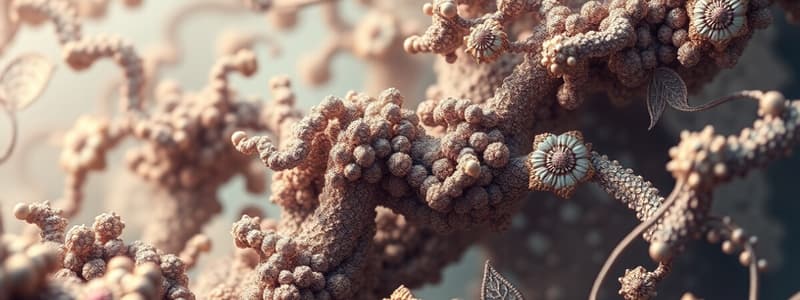Podcast
Questions and Answers
What is a characteristic of enzymes that distinguishes them from other chemical catalysts?
What is a characteristic of enzymes that distinguishes them from other chemical catalysts?
- Enzymes are not changed chemically at the end of the reaction. (correct)
- Enzymes are consumed in the reactions they catalyze.
- Enzymes operate solely in in vitro conditions.
- Enzymes change chemically after the reaction.
Which of the following statements about enzyme specificity is accurate?
Which of the following statements about enzyme specificity is accurate?
- All enzymes have absolute specificity.
- Metabolic enzymes exhibit low specificity.
- Digestive enzymes exhibit high specificity.
- Enzymes interact with either one or a few related substrates. (correct)
Which type of enzyme is characterized by being formed from both an apoenzyme and a cofactor?
Which type of enzyme is characterized by being formed from both an apoenzyme and a cofactor?
- Ribozyme
- Conjugated protein enzyme (correct)
- Simple protein enzyme
- Isoenzyme
Why do most enzymes require only small amounts for chemical reactions?
Why do most enzymes require only small amounts for chemical reactions?
Which of the following best describes the relationship between enzyme nomenclature and their action?
Which of the following best describes the relationship between enzyme nomenclature and their action?
Which statement correctly describes a coenzyme?
Which statement correctly describes a coenzyme?
What is the primary role of the active site in an enzyme?
What is the primary role of the active site in an enzyme?
Which statement about metalloenzymes is accurate?
Which statement about metalloenzymes is accurate?
Which of the following best represents the induced fit theory?
Which of the following best represents the induced fit theory?
Which characteristic is true for a prosthetic group?
Which characteristic is true for a prosthetic group?
What characterizes an exothermic reaction?
What characterizes an exothermic reaction?
What role does ATP play in endothermic reactions?
What role does ATP play in endothermic reactions?
At what substrate concentration does the reaction velocity become non-linear with respect to substrate concentration?
At what substrate concentration does the reaction velocity become non-linear with respect to substrate concentration?
What does a lower Km value signify regarding an enzyme's affinity for its substrate?
What does a lower Km value signify regarding an enzyme's affinity for its substrate?
Which of the following is true about isothermic reactions?
Which of the following is true about isothermic reactions?
How does an increase in cofactor concentration impact the reaction velocity?
How does an increase in cofactor concentration impact the reaction velocity?
What happens to the reaction velocity when substrate concentration exceeds the Km value?
What happens to the reaction velocity when substrate concentration exceeds the Km value?
What is the limiting factor for the reaction velocity when enzyme concentration is increased beyond Vmax?
What is the limiting factor for the reaction velocity when enzyme concentration is increased beyond Vmax?
What role does phosphorylation play in enzyme activity?
What role does phosphorylation play in enzyme activity?
Which of the following is NOT a classification of enzymes according to IUBMB?
Which of the following is NOT a classification of enzymes according to IUBMB?
Which statement about the compartmentation of enzymes is correct?
Which statement about the compartmentation of enzymes is correct?
Which type of enzyme is responsible for breaking down substrates without the addition of water?
Which type of enzyme is responsible for breaking down substrates without the addition of water?
What is the function of phosphatases in enzyme regulation?
What is the function of phosphatases in enzyme regulation?
What happens to the velocity of a reaction when the concentration of products increases?
What happens to the velocity of a reaction when the concentration of products increases?
At what temperature do most enzymes typically exhibit maximum activity?
At what temperature do most enzymes typically exhibit maximum activity?
Which statement accurately describes the effect of competitive inhibitors on enzyme kinetics?
Which statement accurately describes the effect of competitive inhibitors on enzyme kinetics?
What is unique about the optimum pH for the enzyme pepsin compared to most other enzymes?
What is unique about the optimum pH for the enzyme pepsin compared to most other enzymes?
What impact does a competitive inhibitor have on the substrate concentration required for enzyme activity?
What impact does a competitive inhibitor have on the substrate concentration required for enzyme activity?
Which of the following substances is categorized as a competitive inhibitor?
Which of the following substances is categorized as a competitive inhibitor?
At what temperature does enzyme activity typically stop due to denaturation?
At what temperature does enzyme activity typically stop due to denaturation?
What type of inhibitor competes for the same binding site as the substrate?
What type of inhibitor competes for the same binding site as the substrate?
Which competitive inhibitor matches with its function and competitor?
Which competitive inhibitor matches with its function and competitor?
What effect does a competitive inhibitor have on the Km and Vmax
What effect does a competitive inhibitor have on the Km and Vmax
What effect does an allosteric inhibitor have on the Km and Vmax?
What effect does an allosteric inhibitor have on the Km and Vmax?
Flashcards are hidden until you start studying
Study Notes
Enzymes
- Biological catalysts that speed up chemical reactions without being consumed in the process.
- Mostly proteins, but some are RNA molecules called ribozymes.
- Do not alter the equilibrium constant of a reaction, they only affect the rate at which equilibrium is reached.
- Exhibit high specificity, acting on specific substrates or a limited number of related substrates.
Enzyme Nomenclature
- Old Method: Simple names like Pepsin, Trypsin, Chymotrypsin, Rennin.
- New Method:
- Hydrolases: Substrate + "ase", e.g., sucrase, urease, arginase, glucosidase.
- Other Actions: Substrate + action of the enzyme, e.g., Lactate dehydrogenase, Pyruvate carboxylase, Adenylate cyclase.
Enzyme Specificity
- Based on the precise arrangement of chemical groups at the active site.
- Absolute specificity: Enzyme interacts with only one specific substrate.
- Relative specificity: Enzyme interacts with a small number of related substrates.
Importance of Enzyme Specificity
- Digestive enzymes: Low specificity, allowing a small number of enzymes to digest a wide range of food substances.
- Metabolic enzymes: High specificity for precise regulation of metabolic pathways.
Chemical Nature of Enzymes
- Simple protein enzymes: Composed solely of amino acids.
- Conjugated protein enzymes: Consist of a protein part (apoenzyme) and a non-protein part (cofactor).
Conjugated Protein Enzymes
-
Holoenzyme: The active form of the enzyme, containing both the apoenzyme and cofactor.
-
Apoenzyme: Inactive protein component.
-
Cofactors: Non-protein components that aid in enzyme activity.
- Coenzymes: Organic cofactors, either prosthetic groups or co-substrates.
- Prosthetic Group: Tightly bound to the apoenzyme by covalent or non-covalent bonds.
- Co-substrate: Loosely bound to the apoenzyme.
- Metal Ions: Inorganic cofactors.
- Metalloenzymes: Metal ions tightly bound to the apoenzyme.
- Metal-activated enzymes: Metal ions loosely bound to the apoenzyme.
Mechanism of Enzyme Action
- Active site (catalytic site): Region on the enzyme with a specific shape complementary to the substrate.
- Contains specific amino acid residues arranged for substrate binding and catalysis.
- Allosteric site: Binds to regulatory molecules (activators or inhibitors), modifying enzyme activity.
Theories of Enzyme Action
- Induced Fit Theory: When the substrate approaches the enzyme, the active site conforms to the shape of the substrate, forming an enzyme-substrate complex.
- Thermodynamic Changes:
- Enzymes lower the activation energy required for the reaction to occur.
- Do not affect the equilibrium constant (ΔG remains the same).
- ΔG = Energy of products - Energy of substrates.
Types of Reactions
- Exothermic reactions (Exergonic): Release energy, ΔG is negative, irreversible.
- Example: ATP → ADP + Pi
- Endothermic reactions (Endergonic): Require energy, ΔG is positive, require coupling with exergonic reactions.
- Example: A + B + ATP → C + ADP + Pi
- Isothermic reactions: No net energy change, ΔG is zero, reversible.
- Example: A + B → C + D
Factors Affecting Enzyme Activity
- Substrate Concentration [S]:
- Increased substrate concentration generally increases reaction velocity until the enzyme is saturated.
- Km (Michaelis Constant): Substrate concentration at which the reaction velocity is half of the maximum velocity (Vmax).
- Vmax: Maximum velocity of the reaction when the enzyme is fully saturated with substrate.
- Michaelis-Menten equation: Describes the relationship between reaction velocity, substrate concentration, Km, and Vmax.
- Vi = Vmax [S] / (Km + [S])
- Significance of Km:
- Indicates the affinity of the enzyme for the substrate (lower Km = higher affinity).
- Differs between isoenzymes and for different substrates of the same enzyme.
- Inhibitors can increase Km by reducing the affinity between enzyme and substrate.
- Enzyme Concentration [E]:
- Increased enzyme concentration generally increases reaction velocity until the substrate concentration becomes the limiting factor.
- Cofactor Concentration [C]:
- Increased cofactor concentration generally increases reaction velocity until the enzyme concentration becomes the limiting factor.
- Product Concentration [P]:
- Increased product concentration usually inhibits the reaction.
- Temperature:
- Most enzymes have an optimum temperature (around 37°C for human enzymes, 50°C for plant enzymes).
- Below the optimum temperature, activity decreases due to reduced collision rate.
- Above the optimum temperature, activity decreases due to enzyme denaturation.
- pH:
- Each enzyme has an optimum pH for maximal activity.
- Activity decreases at pH levels above or below the optimum.
Inhibitors
-
Substances that reduce enzyme activity.
-
Competitive inhibitors: Resemble the substrate and bind to the active site, preventing the substrate from binding.
- Inhibition is reversible and can be overcome by increasing substrate concentration.
- Examples: Sulfanilamide, Allopurinol, Dicumarol, Warfarin, Statins.
-
Other inhibitors:
- Allosteric inhibitors: Bind to a site other than the active site (allosteric site), causing a conformational change that inhibits activity.
- Covalent Modification: Enzymes can be activated or inhibited by phosphorylation or dephosphorylation.
- Compartmentation of enzymes: Localization of enzymes in specific cellular compartments or organelles regulates their activity.
Classification of Enzymes
- IUBMB (International Union of Biochemistry and Molecular Biology):
- Hydrolases: Break down molecules by adding water.
- Oxidoreductases: Catalyze oxidation-reduction reactions.
- Transferases: Transfer functional groups between molecules.
- Lyases: Break down molecules without adding water.
- Isomerases: Rearrange atoms within a molecule.
- Ligases: Join two molecules together.
Studying That Suits You
Use AI to generate personalized quizzes and flashcards to suit your learning preferences.



